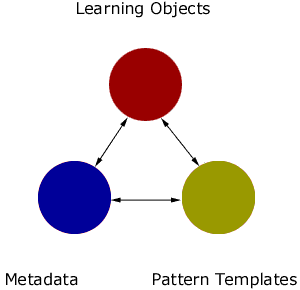| THE VISION |
|
Everyday we are flooded by new information that demands our attention. Software and plugins, intranets, the internet, newsgroups, then the waters rise even higher when you add the media and publishing devoted to explaining new technology. We need more efficient ways to access this information. When search engines return millions of results, we must learn how to design information from the bottom up. In object-oriented programming, data is grouped in discrete modules called objects. Each is assigned a set of attributes that determine how it is manipulated. This design is so powerful that it enables us to describe and manipulate complex objects in 3D space. Bottom-up design of modular objects is now applied to instructional content.
In modular content design, information is chunked into discrete content modules called learning objects. Learning objects may be tagged with metadata attributes that classify the modules according to function. Pattern templates allow them to be accessed and reused in different sequences in order to teach different subjects. Modular content design enables us to use software engines to create and deliver instructional content across all platforms - including CD-ROMs, web sites, intranets, and servers. |
